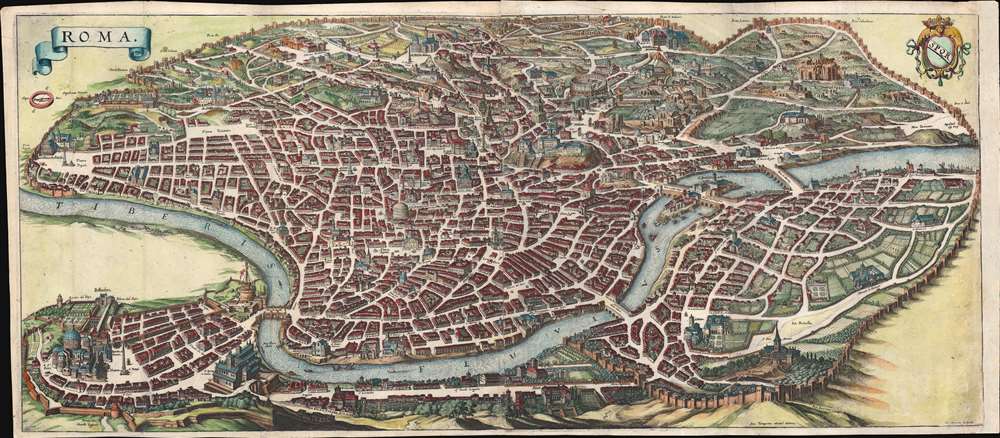This item has been sold, but you can get on the Waitlist to be notified if another example becomes available, or purchase a digital scan.
1642 Merian Panoramic View or Map of Rome, Italy
Roma-merian-1642-2
Title
1642 (undated) 12.5 x 28.5 in (31.75 x 72.39 cm)
Description
The Column of Antononi the Pius
The Column of Antononi the Pious, for example, is depicted in its full glory, including its magnificent base. One might suppose, from 1703 excavation records, that most of the column, including the base, was buried in the 17th century, but here full knowledge of the column's form and design are evident - solving a mystery! This map also includes some of the only surviving visual representations of Rome's early churches, many of which were replaced with grander structures in the 18th century.Publication History and Census
Issued for inclusion in Matthäus Merian 's 1642 Theatrum Europaeum. Although we don't have records of how many of this map Merian originally printed, we are aware that it was printed by both Merian and his sons until about 1560, all from the same plate, such that examples from different years are mostly indistinguishable. We have identified roughly 21 examples in major institutional collections as well as, presumably, a number of additional examples in private hands.CartographerS
Matthäus Merian (September 22, 1593 - June 19, 1650), sometimes referred to as 'the Elder' to distinguish from his son, was an important Swiss engraver and cartographer active in the early to mid 17th century. Merian was born in Basel and studied engraving in the centers of Zurich, Strasbourg, Nancy and Paris. In time Merian was drawn to the publishing mecca of Frankfurt, where he met Johann Theodor de Bry, son of the famed publisher Theodor de Bry (1528 - 1598) . Merian and De Bry produced a number of important joint works and, in 1617, Merian married De Bry's daughter Maria Magdalena. In 1623 De Bry died and Merian inherited the family firm. Merian continued to publish under the De Bry's name until 1626. Around this time, Merian became a citizen of Frankfurt as such could legally work as an independent publisher. The De Bry name is therefore dropped from all of Merian's subsequent work. Of this corpus, which is substantial, Merian is best known for his finely engraved and highly detailed town plans and city views. Merian is considered one of the grand masters of the city view and a pioneer of the axonometric projection. Merian died in 1650 following several years of illness. He was succeeded in the publishing business by his two sons, Matthäus (1621 - 1687) and Caspar (1627 - 1686), who published his great works, the Topographia and Theatrum Europeaum, under the designation Merian Erben (Merian Heirs). Merian's daughter, Anna Maria Sibylla Merian, became an important naturalist and illustrator. Today the German Travel Magazine Merian is named after the famous engraver. More by this mapmaker...
Antonio Tempesta (1555 - August 5, 1630), known as 'Il Tempestino' was an Italian painter and engraver. Tempesta was born in Florence where he trained in painting and engraving, matriculating in 1576 at the Florentine Accademia delle Arti del Disegno. He worked in the Baroque ethic and is known as a Counter-Mannerist. He studied in painting in the school of Santi di Tito (December 5, 1536 - July 25, 1603). In cartographic circles he is best known for his expansive 12-sheet bird's-eye style perspective panorama of Rome, issued in 1593. This view is rare, but was later reduced and republished by Matthäus Merian (1593 - 1650). Learn More...

